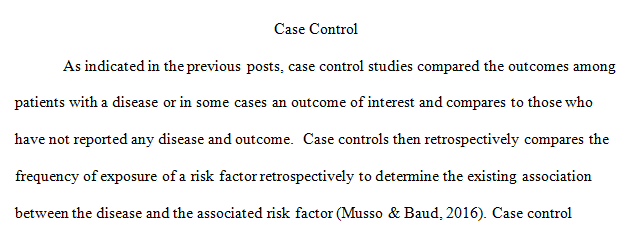
he problems with questionnaire-based case-control studies on the epidemiology of glioma. British journal of cancer
Case Control
IMPORTANT NOTE REGARDING WORD LIMIT REQUIREMENTS:
Please note that each and every assignment has its own word limit.
In a case-control study the prevalence of exposure to a potential risk factor(s) is compared between cases and controls. A major characteristic of case-control studies is that data on potential risk factors are collected retrospectively and as a result may give rise to bias. Case control studies are observational because no intervention is attempted, and no attempt is made to alter the course of the disease. The goal is to retrospectively determine the exposure to the risk factor of interest from each of the two groups of individuals cases and controls. These studies are designed to estimate odds.
Case-Control studies can usually be conducted relatively faster and are inexpensive when compared with cohort studies (prospective). It is useful to study rare outcomes and outcomes with long latent periods. It is also useful to study multiple exposures in the same outcome. Case-control studies are useful to study the association of risk factors and outcomes in outbreak investigations. The case-control studies are also prone to certain biasesIn general, individuals may not be able to recall all exposures accurately. Furthermore, cases are more likely to remember detailed exposure history (particularly behaviors such as dietary habits) compared with controls – particularly population-based controls. This may lead to recall bias If the cases and controls are not selected similarly from the study base, then it will lead to selection bias (Setia, 2016).
The main limitation of using questionnaires to assess exposure is recall bias. There are also limits to how much can be asked on a single questionnaire, how frequently it can be administered, and how specific it can be made. In questionnaire-based case–control studies, it is anticipated that cases can recall past events with sufficient accuracy. (Johansen, Schüz, Andreasen, & Dalton, 2017). Patient rosters at medical facilities, Death certificates and Disease registries examples of alternative strategies for collecting this information in a case-control study.
Reference
Johansen, C., Schüz, J., Andreasen, A. S., & Dalton, S. O. (2017). Study designs may influence results: the problems with questionnaire-based case-control studies on the epidemiology of glioma. British journal of cancer, 116(7), 841–848. https://doi.org/10.1038/bjc.2017.46
Setia M. S. (2016). Methodology Series Module 2: Case-control Studies. Indian journal of dermatology, 61(2), 146–151. https://doi.org/10.4103/0019-5154.177773
Respond to the bold paragraph ABOVE by using one of the option below… in APA format with At least two references and a minimum of 200 words….. .(The List of References should not be older than 2016 and should not be included in the word count.)
- Ask a probing question.
- Share an insight from having read your colleague’s posting.
- Offer and support an opinion.
- Validate an idea with your own experience.
- Make a suggestion.
- Expand on your colleague’s posting.
Be sure to support your postings and responses with specific references to the Learning Resources.
It is important that you cover all the topics identified in the assignment. Covering the topic does not mean mentioning the topic BUT presenting an explanation from the context of ethics and the readings for this class
To get maximum points you need to follow the requirements listed for this assignments 1) look at the word/page limits 2) review and follow APA rules 3) create subheadings to identify the key sections you are presenting and 4) Free from typographical and sentence construction errors.
REMEMBER IN APA FORMAT JOURNAL TITLES AND VOLUME NUMBERS ARE ITALICIZED.
4 hours ago
REQUIREMENTS
NYU
Masters Health & Medical
Answer preview…………………..

apa 318 words